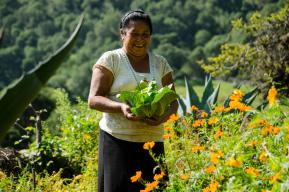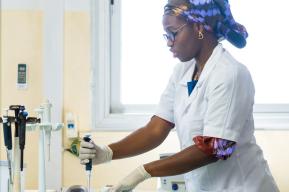News
Five trailblazers win UNESCO–AI Fozan International Prize for the Promotion of Young Scientists

This is the first edition of the biennial prize, which was established by UNESCO in 2021 in partnership with the Al–Fozan Foundation in Saudi Arabia. The jury was composed of three scientists: Dr Edna Matta-Camacho, a structural biologist (Colombia) who founded STEM Tolina, an educational programme; Professor Didier Queloz (Switzerland), who shared the Nobel Prize for Physics with Michel Mayor in 2019 for the discovery of the first exoplanet; and Dr Fadji Zaouna Maina (Niger), an Earth scientist from the NASA Goddard Space Flight Center in the USA.
Dr Federico ARIEL (40 years old, Argentina)
Dr Ariel’s pioneering research has deepened our understanding of the role that long noncoding RNA plays in plants. In much the same way that the emergence of RNA-based vaccines proved a life-saver during the recent pandemic, the development of RNA-based technologies that can replace harmful synthetic pesticides will ensure a safer environment for humans and nature.
His work established the basis for the use of RNAs to deliver information to plants using an approach that avoids recourse to genetically modified organisms (GMOs). He designs special RNA molecules that act as exogenous natural substances to help plants adapt to environmental stress and resist harmful pathogens, thereby reducing the need for synthetic pesticides. One of his key achievements is the development of a platform to control gene expression in both plants and pathogens. This breakthrough will enable us to protect crops from pests and help them withstand heat waves using a GMO-free approach.
To advance his work, Dr Ariel has established his own startup, APOLO Biotech, with the backing of the National Research Council (CONICET) in Argentina, where he is a group leader.
Professor Abdon ATANGANA (37 years old, Cameroon)
Prof. Atangana has made significant contributions to the field of mathematics, particularly in the areas of fractional calculus, fractional differential equations, and mathematical modelling. These allow us to model complex phenomena to solve real-life problems such as the spread of infectious diseases, heat transfer problems, groundwater flow and contamination or weather patterns.
He has suggested differential operators which can replicate complex processes that are hard to predict. He has also introduced a new methodology for assessing the impact of infectious diseases on groundwater.
This type of interdisciplinary research can be applied to industry, such as in the development of the cruise control function in cars. By using fractional calculus to further our understanding of the intricate dynamics of heat transfer, the flow of fluids and other physical phenomena, his work is contributing to new strategies for minimizing energy consumption and optimizing renewable energy systems.
Abdon Atangana is a Professor at the University of the Free State in in Bloemfontein, South Africa.
Professor Qiaomei FU (39 years old, China)
Prof. Fu has retrieved DNA from ancient human remains and sediments to construct an evolutionary map of Eurasian (especially East Asian) populations over the past 100,000 years. These findings reveal unique human diversity and provide insights into how the ancestries discovered by Fu’s team shaped the genetic makeup and adaptive traits of humans today.
One of her team’s findings indicates that populations related to the Tianyuan Cave individual (see photo) were widely distributed in East Asia before the Last Glacial Maximum (26,500–19,000 years ago) and may have disappeared at the end of this period. By that time, the earliest ancient northern East Asian populations had emerged and mutations in a gene that is responsible for the development of skin tissue had also appeared; these mutations are associated with typical features unique to East Asia such as thicker hair and more sweat glands, reflecting the influence of genetic selection in low ultraviolet environments. From 14,000 years ago, the populations in northern East Asia remained relatively continuous and became the most direct and well-supported source of East Asian ancestry in Native Americans.
Prof. Fu is a palaeogeneticist at the Institute of Vertebrate Paleontology and Paleoanthropology of the Chinese Academy of Sciences in Beijing.
Dr Hesham OMRAN (38 years old, Egypt)
Dr Omran has led the development of a novel toolbox which enables scientists and engineers to create more efficient semiconductor chips, essential ingredients in today’s electronic devices including computers, mobile phones, medical devices, and electric vehicles. What used to take days or weeks of manual work can now be accomplished in just minutes.
Full-custom semiconductor chip design has historically relied heavily on manual efforts by expert designers, making it a complex and time-consuming process. Dr Omran’s tool, the Analog Designer's Toolbox (ADT), dramatically reduces the time required to design full-custom integrated circuit blocks.
Dr Omran is an Associate Professor at Ain Shams University, Cairo, Egypt. He is also a co-founder of Master Micro, a startup based in Egypt that addresses challenges related to automating the design of electronics. This start-up is the first of its kind in the Arab world. In parallel, he has shared his knowledge of microelectronics with the public through his Mastering Microelectronics YouTube channel, which has garnered over 1.2 million views and 12,000 subscribers, many of whom come from Arabic-speaking countries.
Dr Jelena VLADIC (37 years old, Serbia)
Dr Vladic has developed innovative ecological extraction processes to obtain products from aromatic and medicinal plants and add value to food and agricultural waste.
Moreover, she has used microalgae from wastewater treatment to extract bioactive compounds. Although microalgae are known for being rich in nutrients and health-relevant components, those grown in wastewater are typically considered unsafe for human and animal use, owing to their origin and potential contamination. However, Jelena Vladic's breakthrough research has discovered that a green solvent called subcritical water can effectively purify microalgae biomass derived from wastewater treatment. This extraction process eliminates pathogens and ensures that the liquid extracts obtained are safe and contain bioactive components that could be utilized in diverse industries. Her approach could contribute to a truly circular economy.
Dr Vladic is a former faculty member of the Technology University of Novi Sad, Serbia, and currently affiliated to the NOVA School of Science and Technology of NOVA University in Lisbon, Portugal.








